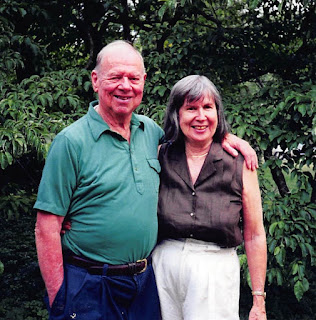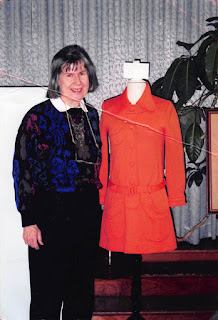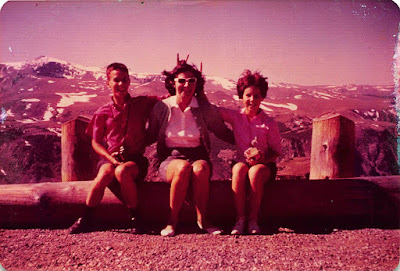 |
| Dad, Art Fogel, and Marilyn (2 years old) examining plant specimens, 1954 |
As a very young child, I was a wanderer.
At the age of only two, I walked about 200 yards through the parking lots of
our apartment building to a local grocery store across a fairly busy street.
That was in 1955, so there weren’t the zippy cars of today with distracted
drivers. I walked myself back home into our apartment without my mother being
any wiser. After we moved to our suburban home on Greenvale Road in Moorestown
NJ, I lived next door to a gang of adventurous kids—David and Richie Furhman
and Albert and Franny Stein. My brother Fred (then called Freddy) was a close
partner in all of my adventures as a child as well. Together, we called
ourselves the Greenvale Raiders. We roamed the neighborhood before it was built
out with other houses. Wandering led me to investigate the natural world.
Our “home range” was about a mile, a
distance that tethered kids these days rarely travel on their own. We
especially liked to build bridges with branches and sticks over small streams
and creeks. On nice days, we made our way to Moorestown’s Strawbridge Lake
where I caught small fish and tadpoles. Without any knowledge of what science
was or what a scientist did, I began observations of the natural world here. In
3rd grade at the age of 9, I started keeping a weather diary noting daily
temperatures, cloud types, and precipitation. In summers, I made live insect
collections kept in Mason jars on the back patio. By the age of 10, I was
creating small mesocosms of plants and animals in jars so I could observe
semi-natural habitats.
The Greenvale Raiders were intensely
following NASA’s early astronauts in the Mercury space program listening to the
launches and landings on transistor radios. In 1961, we “launched” my hamster,
Creampuff, into “space” with a large box kite that we’d built together. When
the hamster “touched down” to earth, we had a victory parade around the block
with the hamster proudly displayed in a Radio Flyer red wagon. In 6th
grade (11 years old), I wrote an essay my father saved highlighting that when I
grew up, I wanted my own chemistry lab, 4 children, and 6 dogs.
 |
| Arthur and Florence Fogel, circa 1988 |
My parents played supportive roles
that aren’t in any way similar to the way that parents have today for
encouraging STEM in their kids--enrolling in summer science camps or after
school science programs and buying them computers. My father, Arthur Fogel, was
raised in a rural community, served as a Lieutenant in the US Navy on a
submarine in World War II, and earned a degree in electrical engineering at
Penn State. He worked his whole career at RCA (Radio Corporation of America) in
Camden NJ as the head of the transformer division, which made important parts
for all of the space missions. Our family was the first in the neighborhood to
have a color TV, because RCA designed and built them. My dad was an avid
hunter, fisherman, and gardener—hobbies he learned growing up in the eastern
part of Pennsylvania. Every summer, we headed out to points north or west to
visit national parks, fishing spots, and historic sites, in particular
battlefields.
At home, we had the only vegetable
garden that I knew of. Every summer my father grew tomatoes, beans, corn,
radishes, and lettuces that we ate with relish. He also grew a profusion of
different flowers—tulips, irises, dahlias, zinnias, and marigolds. I had my own
3 x 3 foot garden plot, chose my own seeds to plant, and managed my garden from
the age of about 7 and older. With him, I was comfortable being in the out of
doors, loved working in soil, and liked getting dirty! I also learned to use
tools from him. First, gardening tools, then hammers, saws, wrenches, and
screwdrivers. We built a dollhouse, a birdhouse, and a rabbit hutch together.
When I was about 12 years old, he taught me how to load and fire a rifle and a
shotgun. I never hunted, but I was familiar with guns and learned to respect
them. Although he was an engineer and not a scientist, he taught me things that
were considered “boy’s stuff”, that bolstered me as a female scientist in a
largely male world.
 |
| My family's "Hunting Cabin" in remote Pennsylvania |
My mother, Florence Fogel, was more
of an indoor person and grew up in urban Camden, New Jersey. But she was creative, artistic, and loved to try new
things. I learned to sew, clean bathrooms, knit, iron clothing, and make
curtains from her. Every year, I chose a different craft project that she
helped me figure out. I was provided with coloring books, paints, scrapbook
materials, and any sewing supplies I wanted. Together we designed my wardrobe,
bought the materials, and constructed the outfits until I was in my early 30s!
She took our Girl Scout troop on bike rides, to the racetrack, and camping. I
would have been more content to sit in my room and read a book, but she
encouraged me to break out of my shell and try new things. Neither parent ever
imagined they’d raise a child, a daughter no less, to be a world-renowned
scientist.
 |
| Florence Fogel with dress designed for Marilyn circa 1970 |
I was always an avid reader and
finished all of our libraries’ books about dogs and horses, which I loved. At
home, I had a set of the Golden Nature Guides on birds, flowers, trees, rocks
and minerals, and weather. I kept these close by my bed and consulted them
frequently when I observed something new in the neighborhood. I marked the pages
with check marks when I identified a new species. It was a matter of personal
pride that I knew all of the mammals from all of the continents. I kept
scrapbooks with pictures of animals. As a child, I had no recognition that
everyone didn’t have the same interest in the natural world as I did.
In 6th grade (11 years
old), I wrote the following, dated Sept. 5, 1963, after a spectacular summer vacation to the
Wild West. Having an opportunity at a young age to see such spectacular places
surely influenced me.
This summer we went to Wyoming and Montana.
We saw some moose, bear, and marmits (sic) in Yellowstone National Park. We
stayed at Cooke City in Montana. One day we went fishing. You had to hike back
about 3 miles over mountains. The flys (sic) and mosquitos were bad that day
and it was hot. When we got there we had drank all the water we brought. So we
found a fresh stream and filled up the thermos jug. I caught 2. Altogether we
had 14 fish. We got firecrackers in Wyoming and set them off on the Fourth of
July. We went to two rodeos. I nearly froze at one of them. We met our friends
that we had a barbecue with four years ago. I went horse back riding there and
you could gallop all you wanted. Also I saw a square dance on horses. There was
a creek in front of our cabin. You couldn’t swim in it because the current was
to swift. I took a raft down it and over the rapids. There were cows on the
other side of the creek. One had one horn. At night they had a roundup. I
couldn’t sleep because of the mooing. We got home in 3 ½ days. We drove from
five in the morning to seven at night. One motel stopped had an indoor swimming
pol. We got home on July 16.
I returned
to Yellowstone almost 20 years later as a scientist and spent three years
studying its natural environments.
 |
| Brother Fred Fogel, Mom Florence Fogel, and Marilyn, Beartooth Mtn. Pass, Montana, 1963 |
My interest in meteorology, biology,
entomology, and space studies didn’t register as necessarily important to me as
a child, but the science gene was there. In junior high school (12-14 years
old), I had two male science teachers who I thought were rock stars. Mr. Parks supposedly
taught us earth science and biology, but I recall him taking us out to the
parking lot and teaching us the names of all the parts of a car and how
automobiles worked. He also brought in chicken embryos, clams, and worms for us
to dissect. Somehow he knew someone in the medical field who had a human brain
in a bowl that he brought in to show us. We got to touch it! I thought that was
so cool. Mr. Barnosky taught chemistry, in particular he taught us about
isotopes—something I’ve centered my career on. While I enjoyed other subjects
like Geography and Math, the science classes were the most fun.
In high school, my favorite classes
were Chemistry and Biology. At the time, I thought the interest was due to the
fact that I had good teachers, a factor that surely influenced me. Mr.
Boehmler, my Chemistry teacher, had a droll way of explaining with simple
precision the nature of chemical bonds, reaction mechanisms, and physical
properties of various compounds. A trim man with horn-rimmed glasses, always
wearing a white shirt and tie, he presided over chemistry labs with patience
and calmness. When students dropped glassware, he looked sternly towards the
careless student and asked, “Did it break?” Amidst the hormonal ups and downs
of high school, I managed to learn enough chemistry to place out of the first
college class at Penn State.
In the 1960s, we didn’t have science
fairs. My parents weren’t scientists. When I look back at my interests, I can
clearly see the start of the pathway forming my long scientific career. The
early interest in dogs and horses—something many girls are taken with—seemed
fairly normal. But, being comfortable in the natural world and being allowed to
roam, enjoy touching bugs, going fishing, and being at home in the out of doors
was not readily associated with being a girl at this time. I was fortunate that
my parents never pushed me to more girly pursuits and away from informal
science. I was lucky to be able to recognize that feeling of “fit” and “fun”
when I started my academic career at Penn State as a biology major. I have never
looked back.




No comments:
Post a Comment